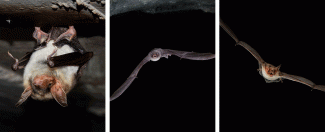New paleoclimate dataset derived from bat guano provides insight into climate conditions hundreds of years ago

We just archived our first paleoclimate dataset that reconstructs climate conditions based on bat guano. This new data provides important insights into the Medieval Warm Period (from about 950 to 1250 AD) and the Little Ice Age (from roughly 1450 to 1850 AD) for locations with previously sparse proxy data availability.
Around 200 miles away from Transylvania in Romania, the home of the infamous fictional Count Dracula, is a special place known as Mӑgurici Cave. Within this cave is an area called the Circular Room, where a large colony of bats has lived for many generations. With its ideal climate conditions for these nocturnal creatures, the Circular Room has been home to three main species for hundreds of years: the greater mouse-eared bat, the common bent-wing bat, and the lesser mouse-eared bat.
When bats inhabited the cave from 881 until 1240 AD and again from 1651 onward, they left scientists clues about northwest Romania's climate in the guano they deposited on the cave floor. Over time, the bats built up a more than 9-foot-tall pile of guano whose layers revealed how temperature, precipitation, and the plants growing in the area had changed. How did scientists uncover those clues?
The Evidence in the Excrement
Paleoclimate scientists study substances that accumulate over time. So, after radiocarbon dating the guano to determine when specific layers were deposited, the scientists examined the elements and isotopes within them to identify the prevalent conditions at the time of their formation. Specifically, the scientists creating this dataset looked at isotopes of nitrogen and carbon. Their first step was to study the elements and compare them to climate patterns captured in the instrumental record.
Because of certain soil processes, a heavier isotope of nitrogen is taken up by plants during wetter periods. Conversely, during drier periods, plants take up more of a lighter isotope of nitrogen. And, the fingerprint the nitrogen leaves behind can be traced all the way through the food chain from plants to insects to bats and ultimately their excrement, providing a climate history for the vicinity of the cave where bats roost.
Carbon’s isotopic signature can also be traced through the food chain to bat guano. During wetter periods, plants preferentially absorb more of a lighter carbon isotope from the atmosphere. During drier periods, plants lose this preference in order to save water and begin to use more of a heavier carbon isotope from the atmosphere as well.
From Guano to a Goldmine of Climate Data
With this knowledge in hand, the scientists were able to reconstruct the climate conditions in the area going back hundreds of years. They found that both the Medieval Warm Period and the Little Ice Age had substantial impacts on northwestern Romania’s climate. During the Medieval Warm Period, the climate became much drier in the area. But, during the Little Ice Age, conditions gradually became wetter until they abruptly shifted to drier conditions, signaling the end of that climate event in the region around 1893 AD.
As one of the first of its kind, this dataset derived from bat guano provides valuable insights into the ancient climates of Romania. Understanding the past climates of regions like this one can also help researchers better anticipate the course of future changes in Earth's climate system.
Reference: Cleary, D.M., B.P. Onac, I. Tanţău, F.L. Forray, J.G. Wynn, M. Ionita, and T. Tămaş, 2018: A guano‐derived δ13C and δ15N record of climate since the Medieval Warm Period in north‐west Romania. Journal of Quaternary Science, 33: 677-688. DOI:10.1002/jqs.3044




